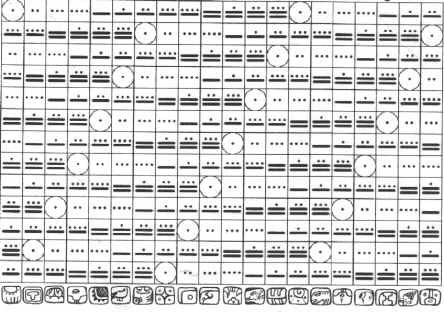The astronomer Philip Plait has stated very clearly that the Mayan calendar does not end in 2012 at all, that it is like the odometer on your car, as each section of the odometer reaches 9 and then clicks over to 0, the next number to it starts a new cycle, so that when all the numbers again reach 0 all the way across the odometer - the last number will change from 1 to 2 and the new cycle starts all over again.

The Mayan Tzolkin
The Tzolkin is a 260-day calendar based around the period of human gestation. It is composed of 20 day-signs, each of which has 13 variations, and was (and still is) used to determine character traits and time harmonics, in a similar way to Western astrology. The Maya also used a 365-day calendar called the Haab, and a Venus calendar, plus others. They measured long time periods by means of a Long Count, in which one 360-day year (a "Tun"), consists of 18 x 20-day "months" ("Uinals"). Twenty of these Tuns is a Katun; 20 Katuns is a Baktun (nearly 400 years); and 13 Baktuns adds up to a "Great Cycle" of 1,872,000 days, ( 5200 Tuns, or about 5125 years).
Mayan scholars have been attempting to correlate the Long Count with our Western Gregorian calendar, since the beginning of this century. There has been massive variation in the suggested correlations, but as early as 1905, Goodman suggested a correlation only 3 days from the most popular one today. Known as the GMT correlation, or "correlation # 584283", this was finalized in 1950, and puts the start of the Great Cycle ( day 0.0.0.0.0) on 11th August 3114 BC, and the end-date (known as 13.0.0.0.0.) as 21st December 2012.
Jose Arguelles has pointed out that the Tzolkin is a harmonic of the Great Cycle, and can be used to map history, as if it is measuring not individual gestation but species gestation, since 5 Great Cycles add to exactly 26,000 Tuns; the "Grand Year" or precession of the equinoxes - a higher harmonic of 260.
No comments:
Post a Comment